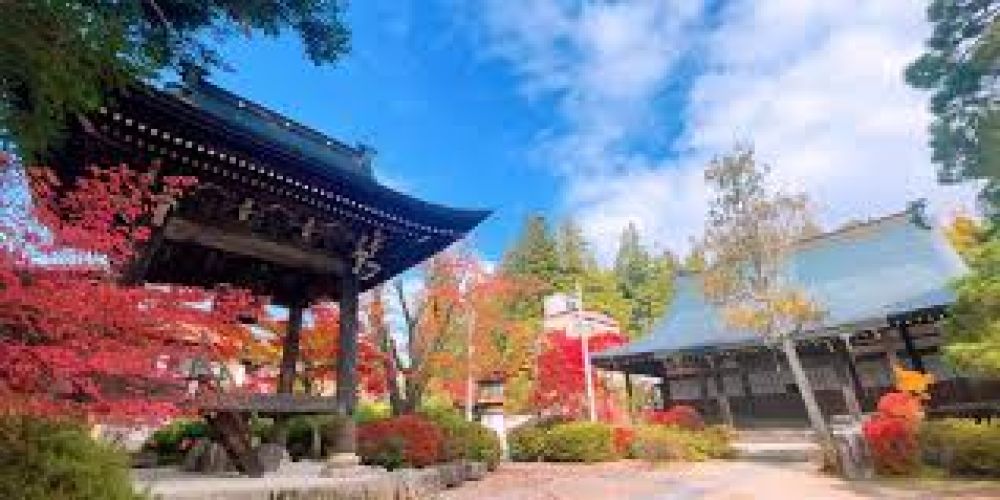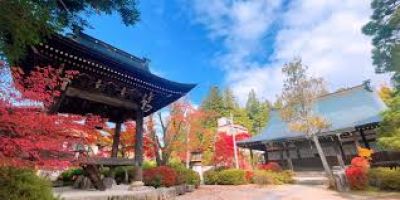

Shiroyama Park, located in the Higashiyama area, offers visitors a serene and historical ambiance. Once the site of Takayama Castle, the park now boasts a tranquil natural environment. Visitors can explore the remnants of the castle's stone walls and moats while enjoying panoramic views of the city and the surrounding mountains. The park is also renowned for its cherry blossoms in the spring, making it a highly sought-after destination for hanami (flower viewing) during that season. Strolling through the park, guests can appreciate various species of trees and plants, providing a relaxing break from the busy city life. The walking paths are well-maintained and lead through gentle hillsides, past quiet ponds, and into small forested areas, enhancing the historical journey through Takayama's samurai and feudal past.
The Higashiyama Temple Walk is a spiritual and cultural journey through a series of temples and shrines spread along the eastern hills of Takayama. This contemplative trail is a path where one can follow in the footsteps of pilgrims and monks from centuries past. It takes visitors through well-preserved temple grounds, stunning Japanese gardens, and impressive gates that tell the story of the city's history and religious significance. Engage with the peaceful surroundings and the intricate architecture that each religious site presents. One of the highlights of this course is the iconic Sakurayama Hachimangu Shrine, known for its grand festivals and unique charm. Visitors gain insight into the religious practices and artistic heritage of Japan as they encounter statues, carvings, and traditional temple structures that have stood the test of time.
Walking through the historic streets of Takayama's Old Town is like stepping back in time to the Edo Period. The well-preserved town offers an array of beautifully maintained merchant houses, sake breweries, and local craft shops. Visitors can savor traditional Japanese sweets, sample the renowned Hida beef, or sip on sake as they wander through the narrow streets lined with wooden buildings. The Old Town area, particularly Sanmachi Suji, the district's main street, provides ample opportunity to admire the charm of Takayama's architecture and to learn about its rich merchant past. Steeped in history, the area offers various museums such as the Takayama Jinya, a former government outpost, or the Fujii Folk Museum which showcases the daily life of the region's inhabitants over the years. Engaging with the local artisans and shopkeepers also gives travelers an intimate look into the crafts and trades that have shaped the local economy.
For those looking to experience the Higashiyama Walking Course with a bit of added charm, the rickshaw tour offers a unique perspective and an effortlessly enjoyable ride. Local guides, often dressed in traditional garb, pull visitors along in a two-wheeled cart while sharing tales and insights into the historic district. As you are guided through the beautiful streets, your rickshaw runner will highlight key points of interest, offer historical anecdotes, and recommend perfect spots for photos. The ride not only offers a break from walking, but also provides personal engagement with someone who deeply understands the area's culture and history. The pace of the rickshaw ride is gentle and soothing, making it a delightful option for all ages, and particularly appealing for those who might find extensive walking challenging.
Part of the Higashiyama Walking Course experience is the opportunity to visit Takayama's morning markets, known as Asaichi. These markets are a daily fixture in the city and have been a part of local life since the 18th century. The most famous ones, Jinya-mae Market near the Takayama Jinya, and Miyagawa Market along the Miyagawa River, offer a plethora of fresh produce, flowers, local crafts, and street food. Visitors can taste regional specialties including pickles, Hida beef skewers, and mochi (rice cakes). Exploring these markets provides a snapshot of regional agriculture and culinary traditions, and offers a lively atmosphere where locals and tourists alike gather to shop and socialize. Engaging with stallholders and trying unique products make for an enjoyable and authentic experience within the heart of Takayama.
As you traverse the Higashiyama Walking Course, make sure to visit the Yoshijima Heritage House. This cultural gem serves as an exemplary model of traditional Japanese architecture and was once the residence of a wealthy sake brewer. The house stands as a testament to the craftsmanship of the Edo period, featuring intricate woodwork, tatami rooms, and a serene interior courtyard. Visitors are invited to step inside and experience the lifestyle of a bygone era. The open rooms and graceful sliding doors afford a look into Japanese aesthetics and residential design. Preserved as a museum, the Yoshijima Heritage House offers a quiet escape from the bustling city and a chance to appreciate the tranquil ambiance of historical Takayama.
Within the Higashiyama Walking Course lies the Hida Kokubun-ji Temple, an ancient Buddhist temple established over 1200 years ago. As the oldest surviving structure in Takayama, it has a storied history and remains a focal point of the area's spiritual landscape. The temple's grounds are home to a three-story pagoda and a giant ginkgo tree that's believed to be over 1200 years old. Visitors can explore the main hall and admire its stunning wood construction and ornamental features. During the visit, travelers can immerse themselves in the contemplative environment, take part in prayer rituals, and enjoy the calming zen garden, which showcases traditional Japanese garden design. Hida Kokubun-ji Temple is an enduring symbol of Takayama's religious heritage and provides a unique opportunity to connect with Japan's ancient Buddhist traditions.
The Takayama Festival Floats Exhibition Hall is a captivating destination that showcases the artistry and history of the Takayama Matsuri, one of Japan's three most beautiful festivals. Visitors to the hall can marvel at several of the actual floats used in the festival parades. These ornate floats (yatai) are lavishly decorated with intricate carvings, metalwork, lacquer, and detailed textile work. Each float is a masterpiece of craftsmanship and represents the skill and pride of Takayama's artisans. The museum offers a close-up view of these floats and provides understanding into the seasonal festivals they celebrate. The exhibition also includes mechanical dolls (karakuri) that perform during the festival, giving guests a glimpse into the elaborate performances that entertain crowds every April and October.
For those interested in a deeper dive into Takayama's culture and history, joining a guided tour is an excellent choice. A knowledgeable local guide can lead you through the Higashiyama Walking Course, sharing insights and anecdotes that you might not discover on your own. The tour covers significant historical landmarks, such as the ruins of Takayama Castle, several of the area's most prominent temples and shrines, and the Old Town. Participants can gain a richer understanding of the city's samurai past, its religious traditions, and its enduring folk arts. With a guide, visitors can also learn about the subtleties of Japanese culture, such as architectural details, garden designs, and local customs. A guided tour is not only informative but also personal, creating a memorable and engaging experience.
After a day of walking through historic Takayama, an evening sake tasting experience offers a delightful way to relax and reflect on your journey. Takayama is famous for its high-quality sake, thanks to the region's pure mountain water and traditional brewing techniques. Visitors can join a sake tasting session at one of the local breweries in the Old Town, where experts explain the sake brewing process, different sake types, and the best ways to enjoy them. Tasting sets usually include a variety of sake, from dry to sweet, and sometimes even limited seasonal brews. For the full experience, pair your sake with some local delicacies, like Hida beef or pickled vegetables. Discovering the nuances of sake flavors and the culture surrounding Japan's beloved rice wine adds a new dimension to the Higashiyama Walking Course adventure.
